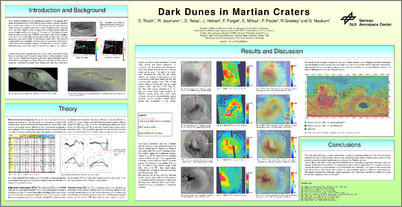|
|
Dark dunes in Martian craters
Tirsch, Daniela und Jaumann, Ralf und Reiss, Dennis und Helbert, Jörn und Forget, Francois und Ehouarn, Millour und Poulet, Francois und Greeley, Ronald und Neukum, Gerhard
(2007)
Dark dunes in Martian craters.
In: Geophysical Research Abstracts 2007, 9.
European Geosciences Union General Assembly 2007, 2007-04-15 - 2007-04-20, Wien (Ö).
ISSN 1029-7006.
![[img]](https://elib.dlr.de/style/images/fileicons/application_pdf.png)  Vorschau |
|
PDF
9MB |
KurzfassungAs a result of weathering and aeolian processes a fine-grained dark material can be found on both Martian hemispheres. It is characterized by a much lower albedo than the surrounding terrain and accumulates in patches and dune fields. Analysis of near infrared spectra from the OMEGA spectrometer yields a higher content of mafic unoxidized minerals such as high and low Ca-pyroxenes and olivine. On impact crater floors, the material is frequently accumulated into barchan or transverse dune fields. HRSC data show that the material is blown into and out of craters, indicating that such depressions can act as traps or as sources. In some cases, dark layers in crater walls with dark streaks running down slope seem to be an additional supply for the dark material. We measured the dune volume using HRSC-DTMs and estimated the total amount of material inside the craters to verify the proportion of the dark layers as a source mechanism for the material inside. So far, no significant relation between crater degradation stage and dune volume could be recognized. Dark streaks extending downwind from the dune on to the surrounding terrain indicate an unconsolidated characteristic of the material and erosion by aeolian scour. However, not every dune suggests a grain release. This poses the question regarding the ages of active dunes, in which some could be "paleo" features. A comparison of modeled wind fields with the morphology related to wind direction suggests that both wind directions do not coincide in every case. For more detailed information concerning the surface properties, we analyzed the night-time brightness temperatures (from THEMIS data) and the thermal inertia (from TES data) of the dune surfaces. If the dune surfaces have warmer brightness temperatures at night with respect to the surrounding, it can be supposed that the surface is consolidated. The dune fields studied show significant differences in night-time brightness temperatures and thermal inertia due to varieties in the physical structure and the grain size of the surface material. The results show that some dune surfaces consist of unconsolidated sandy material that is recently eroded and moved. These dunes are inferred to be active. We assume that dunes with high thermal inertia values, high night-time brightness temperatures and the absence of interaction with the current blowing wind have consolidated surfaces consisting of cemented particles. | elib-URL des Eintrags: | https://elib.dlr.de/48034/ |
|---|
| Dokumentart: | Konferenzbeitrag (Poster) |
|---|
| Titel: | Dark dunes in Martian craters |
|---|
| Autoren: | | Autoren | Institution oder E-Mail-Adresse | Autoren-ORCID-iD | ORCID Put Code |
|---|
| Tirsch, Daniela | NICHT SPEZIFIZIERT | NICHT SPEZIFIZIERT | NICHT SPEZIFIZIERT | | Jaumann, Ralf | NICHT SPEZIFIZIERT | NICHT SPEZIFIZIERT | NICHT SPEZIFIZIERT | | Reiss, Dennis | NICHT SPEZIFIZIERT | NICHT SPEZIFIZIERT | NICHT SPEZIFIZIERT | | Helbert, Jörn | NICHT SPEZIFIZIERT | NICHT SPEZIFIZIERT | NICHT SPEZIFIZIERT | | Forget, Francois | Laboratoire de Météorologie Dynamique du CNRS, IPSL, Université Paris 6, Paris | NICHT SPEZIFIZIERT | NICHT SPEZIFIZIERT | | Ehouarn, Millour | Laboratoire de Météorologie Dynamique du CNRS, IPSL, Université Paris 6, Paris | NICHT SPEZIFIZIERT | NICHT SPEZIFIZIERT | | Poulet, Francois | Institut d’Astrophysique Spatiale, CNRS Université Paris Sud, Orsay, France | NICHT SPEZIFIZIERT | NICHT SPEZIFIZIERT | | Greeley, Ronald | School of Earth and Space Exploration, Arizona State University, Tempe, USA | NICHT SPEZIFIZIERT | NICHT SPEZIFIZIERT | | Neukum, Gerhard | Planetology and Remote Sensing, Free University Berlin, Germany | NICHT SPEZIFIZIERT | NICHT SPEZIFIZIERT |
|
|---|
| Datum: | 15 Januar 2007 |
|---|
| Erschienen in: | Geophysical Research Abstracts 2007 |
|---|
| Referierte Publikation: | Nein |
|---|
| Open Access: | Ja |
|---|
| Gold Open Access: | Nein |
|---|
| In SCOPUS: | Nein |
|---|
| In ISI Web of Science: | Nein |
|---|
| Band: | 9 |
|---|
| Herausgeber: | | Herausgeber | Institution und/oder E-Mail-Adresse der Herausgeber | Herausgeber-ORCID-iD | ORCID Put Code |
|---|
| European Geosciences Union, | NICHT SPEZIFIZIERT | NICHT SPEZIFIZIERT | NICHT SPEZIFIZIERT |
|
|---|
| ISSN: | 1029-7006 |
|---|
| Status: | veröffentlicht |
|---|
| Stichwörter: | Mars, HRSC, dunes, dark material, crater |
|---|
| Veranstaltungstitel: | European Geosciences Union General Assembly 2007 |
|---|
| Veranstaltungsort: | Wien (Ö) |
|---|
| Veranstaltungsart: | internationale Konferenz |
|---|
| Veranstaltungsbeginn: | 15 April 2007 |
|---|
| Veranstaltungsende: | 20 April 2007 |
|---|
|
Veranstalter
: | European Geosciences Union |
|---|
| HGF - Forschungsbereich: | Verkehr und Weltraum (alt) |
|---|
| HGF - Programm: | Weltraum (alt) |
|---|
| HGF - Programmthema: | W EW - Erforschung des Weltraums |
|---|
| DLR - Schwerpunkt: | Weltraum |
|---|
| DLR - Forschungsgebiet: | W EW - Erforschung des Weltraums |
|---|
| DLR - Teilgebiet (Projekt, Vorhaben): | W - Projekt MARS-EXPRESS / HRSC (alt) |
|---|
| Standort: |
Berlin-Adlershof
|
|---|
| Institute & Einrichtungen: | Institut für Planetenforschung > Planetengeologie |
|---|
| Hinterlegt von: |
Tirsch, Daniela
|
|---|
| Hinterlegt am: | 10 Mai 2007 |
|---|
| Letzte Änderung: | 24 Apr 2024 19:10 |
|---|
Nur für Mitarbeiter des Archivs: Kontrollseite des Eintrags
|
|